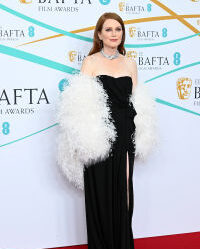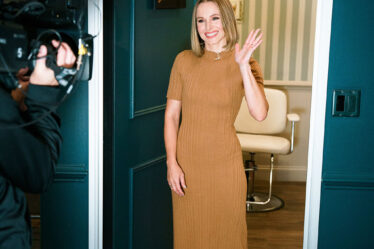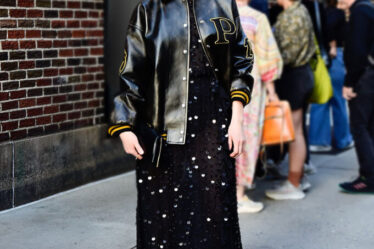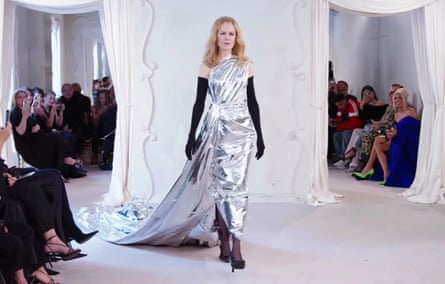
In a year where micro-trends flicked across social media with gut-churning speed and even reaching for pink bismuth could see you branded Barbiecore, fashion did not feel particularly regional.
This likely presented a challenge to the Australian Fashion Council, who were tasked with defining Australian style this year, in their efforts to launch a new trademark. They went with “effortless, raw, boundless, fearless”, which seems like as good a collection of adjectives as any (I would have gone with “salty, crunchy, bright and crisp” if it didn’t sound so much like a packet of Twisties).
But there were a few bites of Australian flavour on the global fashion landscape – from Australian A-listers causing international chatter, to our trend-defying moves toward size-inclusivity (and world-lagging status on waste).
Nicole Kidman: viral fashion muse
Australia’s anonymous, red carpet captioner in chief, Fashion Critical, names Nicole Kidman “modelling for Balenciaga in a piece of tinfoil, to global acclaim”, as her biggest Australian fashion moment of the year. Kidman’s slow walk in that gown – which TikToker Corey O’Brien literally recreated out of tinfoil – was just one of many looks the actor sent viral this year.
In February, she appeared on the cover of Vanity Fair in the microscopic MiuMiu miniskirt that would later be seen everywhere.
Then in August, as the inaugural cover star of Katie Grand’s Perfect magazine, CNN called her one of “fashion’s biggest risk takers”, while Zoe Williams wondered what it would actually take to get that ripped in your 50s.
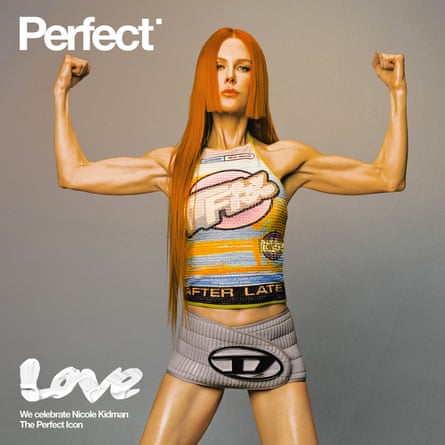
Though, Fashion Critical points out, “we know how things ended up for Balenciaga this year, so there’s that”.
Trashed fashion
Up until this year, there has been reasonable suspicion that Australia has a huge fashion waste problem – but that suspicion was not quantified. A landmark report in July, from the Australian Fashion Council, found that Australians are buying about 14.8kg of clothing a person, a year, and sending about 10kg a year to landfill. As for textile recycling? Wrap Asia Pacific’s Claire Kneller said the figure amounts to “pretty much none”.
Margot Robbie enters her Bottega era
Margot Robbie’s commercial relationship with Chanel, which has been in place since 2018, has been subject to scrutiny and satire.
But the forest green gown from Bottega Veneta she wore to the Governors’ Awards in Los Angeles this November was met with celebration.
The look “reminds us of why we fell in love with her in the first place”, says Getty Images’ Olivia McGrath. “Not only is she an accomplished and talented actor, her pairing of natural, glowy makeup with sleek, sunkissed highlights, brings a quintessential Australian touch to high fashion.”
Meanwhile, Fashion Critical says: “Look, the truth is, there are few things I care about less, than which multimillion dollar contract very rich celebrities have with which horrendously overpriced fashion house.
“That said, I find almost every Chanel outfit trotted out by a celeb on the red carpet to be boring as all get up. So hopefully the shift is good news.”
Inclusive moves
Australia was out of step with the rest of the world in one very good way this year. By mid-November there was much (deserved) hand-wringing over the return of ultra-thinness to runways and red carpets. But Australian fashion week had the most body diverse casting in the event’s history. McGrath describes the week as “a spectacle of different races, abilities, genders and sizes”.

This was coupled with an increase in designers doing made-to-order clothing, or extending their size range beyond 16. But there’s still a long way to go on this front. Many Australian womenswear brands, from high-end labels like Scanlan and Theodore, to high street brands like Kookai, do not make clothing above a size 14 – in other words, their clothes are too small for many Australian women. Fashion Critical points out that even Rebel Wilson’s micro-line of tracksuits did not go above size 14: “Hooo boy,” she says.
Beyoncé’s Brisbane couture
Bethany Cordwell spent her 2020 lockdown cutting 12,000 glistening scales out of a bunch of plastic binders, inspired by the shifts she worked at Officeworks. It wound up being an exceptional use of her time.
Allow Instagram content?
This article includes content provided by Instagram. We ask for your permission before anything is loaded, as they may be using cookies and other technologies. To view this content, click ‘Allow and continue’.
The hypnotic black and white bodysuit she created as part of her Warped Observance collection wound up being worn by Beyoncé, as part of the release of her feted seventh album Renaissance. “I was in shock,” the designer, who now works for the Queensland Ballet Company, told Vogue Australia. “Never in my wildest dreams would I have thought that this could happen.”
The Ken Donessance
Artist Ken Done experienced a resurgence in popularity not seen since his 1980s heyday, between collaborations (with designers Romance was Born and interiors brand Kip and Co) and a projection at Vivid Sydney. His big year was capped off with a nod from the Australian Fashion Laureate, for his lifetime achievements in the industry.
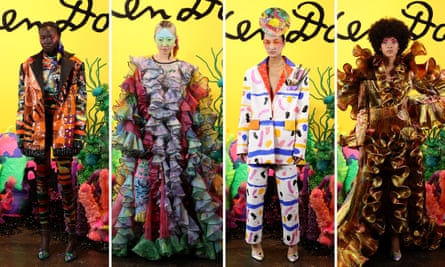
Rental gets a makeover
Australia has been a bit behind the curve when it comes to fashion rental. In other markets, like the UK, it’s been possible to wear almost anything you want, without buying it, for several years. While platforms like GlamCorner and peer-to-peer service The Volte have been around since 2012 and 2016 respectively, up until this year, if you fancied borrowing an outfit that would look out of place at a beach wedding, your options were relatively limited. Now GlamCorner and The Volte have both significantly deepened their offering; and a host of new start-ups have joined them. Most promising is Rntr, which allows Australian brands to offer fashion rentals directly. In March, Rebecca Van Amber, a senior lecturer in fashion at RMIT, noted that the rise of rental means brands have started “redesigning their products to make them more long-lasting”.
Australian red carpets pull it together
“Gone are the days of Aussie stars turning up in humiliating outfits,” says Fashion Critical. “Everyone has a stylist now and their looks are carefully curated just as they are at overseas events.”
After a few years of lower key events, “I think style has improved immensely, if we’re talking about red carpet style. And even before 2019, if you look back at the previous years.”
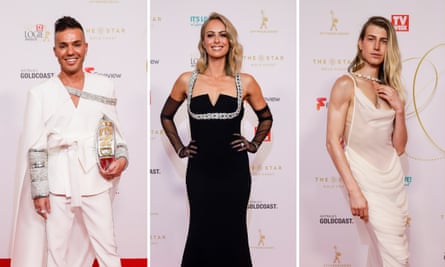
“The Logies was excellent this year,” she says. “It’s disappointing in a way because almost everyone looks lovely, and hence, we cannot mock them mercilessly.”
Fortunately: “The Arias was a hot mess as usual … If everyone looked boring and nice, I would cry.”
Fashion Critical tips Anthony Callea “dressing as Céline Dion” as one of her favourites of the night. “ I am really enjoying the fun that men are finally having on the red carpet, after years of wearing boring as hell black tuxes or suits.”
On that note, she also thanks influencer Christian Wilkins for “every time he stood on a red carpet … he’s a national treasure, frankly”.
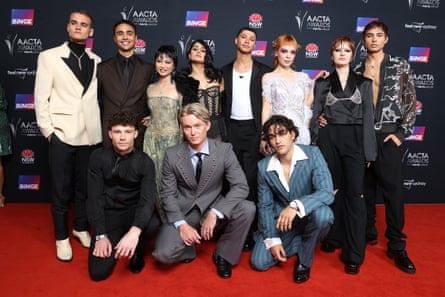
McGrath says the Aacta’s red carpet also “lived up to expectations … Catherine Martin’s Romance Was Born look was a sumptuous feast for the eyes, while Olivia DeJonge looked every bit a Hollywood star in sheer peach.”
Fashion woven into art for the NGV
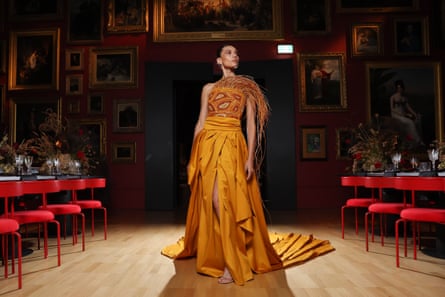
Dramatic, intricately crafted and elegant, one of the most beautiful red carpet looks of the year was also one of the last. At the NGV Gala on 16 December, model Charlee Fraser wore a gown made through a collaboration by Yuwaalaraay woman Julie Shaw of Maara Collective, and master Yolŋu weavers Evonne Munuyngu, Lisa Gurrulpa, Serena Gubuyani, Mary Dhapalany and Margaret Malibirr from Bula’bula Arts.
The dress is the first Indigenous fashion commission from the National Gallery of Victoria. The gown’s bodice was made using hand-dyed and hand-woven pandanus fibres. “I see the weavers as the couturiers, and country as their atelier,” Shaw says.
Next: the rise of fragglecore
With Y2K still (somehow) trending, indie sleaze’s big comeback and a Wednesday-induced wave of dark academia, Fashion Critical has one definitive pick for the first niche aesthetic to trend in Australia for 2023: fragglecore.
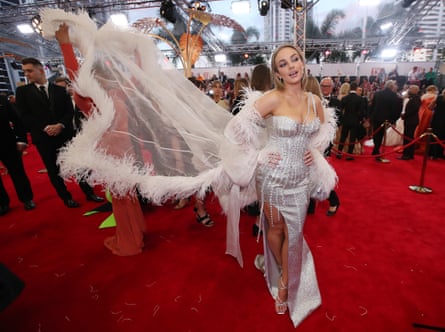
She defines it as: “The fraggling of clothes left and right with their fluffy, feathery fur. It’s been bubbling under the surface for a while,” she says. “But with the re-emergence of Fraggle Rock, the TV show, I think the stars are aligning.”
“This is not good news for our Fraggle friends, but adds a touch of nonsense to fashion, which I enjoy.”

